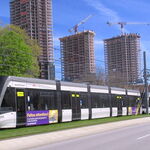steveintoronto
Superstar
Watch this closely:
Chinese truck manufacturer to open Ontario factory, Premier says on trade trip
Chinese truck manufacturer to open Ontario factory, Premier says on trade trip
How is this connected to VIA? It's about electric buses, not trains. Perhaps your point is this could one day move us towards electrified rail at VIA?
Urban Toronto Rules Of Conduct
- Stay on topic. Read the thread subject and previous postings carefully before replying to a topic.
- Make sure your posts contribute something meaningful to the thread.
The Port Hope VIA stop is mostly a commuter stop for Toronto passengers. Port Hope is enough of a bedroom community for there to be ridership for that.
It's a pretty small number of people who do that - Via Rail's website calls it "more than 50 commuters". It's surprisingly quick and affordable though, $15 for a one-way trip if you buy the commuter pass. One hour each way.
And VIA loves it of course, an empty seat thats paid for!
I always wondered about the empty seats on VIA when the train was full. Yesterday I rode VIA to Montreal and the train was declared full, but it was empty. Tomorrow I take the late night train home from Montreal to Toronto, so I'll see how booked it is.By the way, the risk of not getting a seat on train #651, has been addressed by adding a Business Class car, which can not be booked with a Commuter Pass and is therefore less likely to sell out, while taking pressure from the Economy class seats...
- Except that the Commuter Pass credits are refundable and can therefore be re-used for a later booking (within the 30 days of validity of the Commuter Pass), even if the ticket is cancelled only one minute prior to scheduled departure in Port Hope (the last station before Oshawa and thus too late for anyone else to book the seat which suddenly becomes available again).
- Except that the passenger which is turned away due to the lack of any available seats might have been willing to pay the $52+tx for an Economy Plus ticket from Port Hope to Toronto (or even $136+tx from Kingston) - which would have been between 3.6 and 9.4 times the $14.49+tx ($289.80+tx divided by 20) in revenues that credit has generated.
- Except that the passenger which is turned away now has to choose between driving or working from work and therefore won't book and pay for a train ticket to return home later this day.
- Except that the passenger which is turned away will eventually start questioning whether this kind of commute is viable or whether he would have more peace of mind if he just commuted by car (be it to only reach the GO train at Oshawa or all the way to his office).
I always wondered about the empty seats on VIA when the train was full. Yesterday I rode VIA to Montreal and the train was declared full, but it was empty. Tomorrow I take the late night train home from Montreal to Toronto, so I'll see how booked it is.
"Article dumps?" If you'd been following the CRRC, HFR and Bombardier Rail Division merger/buyout discussed at length in this string, you might have connected it.How is this connected to VIA? It's about electric buses, not trains. Perhaps your point is this could one day move us towards electrified rail at VIA?
Is it too much to ask posters to give some context instead of article dumps? What does this have to do with VIA Rail?
Is Thunder Bay next?CRRC to build plant in New Brunswick
Friday May 05, 2017
Written by MA Staff
May 5, 2017 - CRRC has announced it will build a plant in Canada to further expand its marketing channels in North America. The plant will manufacture heavy load, special railway vehicles and railway vehicle brakes.
The new facility, located in Moncton, N.B., will create more than 200 jobs in the first phase and generate more than $1 million in tax revenue for the local government annually, says the company.
The plant was jointly set up by Sichuan-based CRRC Meishan Co., Ltd, a freight train maker under CRRC, Moncton-based ARS Canada Rolling Stock Inc, a local railcar manufacturer and service supplier, and a CRRC subsidiary in Hong Kong. They gained approval from the Canadian government in June 2016.
[...]
http://www.bombardier.com/en/media/...ment-for-nanchang-metro-01.bombardiercom.htmlBombardier’s Chinese Joint Venture to Provide Propulsion and Control Equipment for Nanchang Metro
August 7, 2017 Berlin Transportation, Press Release
[...]
https://www.bnn.ca/bombardier-should-consider-rail-deal-with-china-s-crrc-caisse-ceo-1.902802Bombardier should consider rail deal with China's CRRC: Caisse CEO
Nov 1, 2017
Bombardier Inc should look at all options for its transportation business including partnering with China's state-owned CRRC, one of Bombardier's biggest shareholders said on Wednesday.
"I think we have to look at everything. Every opportunity that comes up ought to be looked at," Caisse de depot et placement du Quebec Chief Executive Officer Michael Sabia told reporters when asked about a deal with CRRC.
Germany's Siemens and France's Alstom said they are merging their train manufacturing operations in September. The move will leave Bombardier competing in a market dominated by CRRC, the world's largest train maker, and a combined Siemens and Alstom group as the second biggest.
Sabia said Bombardier should consider a partnership with CRRC rather than selling the business to the Chinese.
[...]
Ok, dots connected. But what does this have to do with VIA Rail? Why not post this in the Bombardier thread? Does a Chinese buy-out of BBR or start-up mean new rolling stock for VIA? Without more federal funding I can't see how VIA is impacted either way by China opening up a plant."Article dumps?" If you'd been following the CRRC, HFR and Bombardier Rail Division merger/buyout discussed at length in this string, you might have connected it.
Connect the dots. Wynne and the Feds are *inviting*...*enticing* Chinese buying into Cdn rail and auto vehicle plants. CRRC has already bought into Canada:
Is Thunder Bay next?
http://www.bombardier.com/en/media/...ment-for-nanchang-metro-01.bombardiercom.html
https://www.bnn.ca/bombardier-should-consider-rail-deal-with-china-s-crrc-caisse-ceo-1.902802
I state it again:
I stated HFR in my reply. I've discussed in detail prior as to how *vertically integrated company(ies)* will be interested in not only building HFR, but in financing it completely in-house, such that the Infrastructure Bank is cut out of the picture. That then allows the vertically integrated company to not have to tender out the rolling stock. They supply it from their own manufacturing plants.Ok, dots connected. But what does this have to do with VIA Rail? Why not post this in the Bombardier thread? Does a Chinese buy-out of BBR or start-up mean new rolling stock for VIA? Without more federal funding I can't see how VIA is impacted either way by China opening up a plant.
You mean the Tier 4 90mph capable cars with doors at 1/3 2/3 running betwern Pearson and Union? (But without cabs in the flat end cars taking up space)What we realy need i a newly designed RDC type train that meets TC standards and is modern.
Will be interesting to see what the luxury rider thinks of stainless cars when Rocky Mountaineer get their new Stadler kit. I would love to see Amtrak and VIA cooperate on a Superliner 3 concept, in VIA's case for the low platform services west of Toronto, which would allow VIA to operate Ocean with the current Canadian cars. It probably wouldn't compete with Rocky but conservative voices wouldn't be happy if enough money was invested that it did.Philosophical question, would the Canadian still be the Canadian operating without the stainless steel equipment? That train set has become so iconic, it's hard to think of it operating in modern equipment.
Unfortunately, there is no demand for the model. Only two operators bought it: SMART and UPX. The production line is now disassembled and the cost for a unit, expensive as they were when bought during their production run, is now twice or more, if they can even be built again. Nippon Sharyo is having serious problems surviving in entirety. This follows a number of North Am attempts to restart DMU production, the previous one being http://www.usrailcar.com/documents/usrailcar-americasdmu.pdfYou mean the Tier 4 90mph capable cars with doors at 1/3 2/3 running betwern Pearson and Union? (But without cabs in the flat end cars taking up space)
Now that Nippon have lost the Mid West order they were subcontractor on, it's possible there will be more interest in reviving a product they have already done all the R&D on. The difference which you gloss over in your demand that TC grant waivers is the use of PTC in the US where such non-temporal separation waivers have been granted (whereas San Diego's Siemens DMUs run under similar restrictions to O-Train). What was described by @micheal_can was an RDC replacement - Lints are not that, but Nippons are, and are better suited to projects like Halifax commuter than end-door RDCs anyway. I don't see TC changing their tune on having Lints run between Sudbury and White River or even Sarnia-London until the Canadian rail landscape is very different to present conditions.Unfortunately, there is no demand for the model. Only two operators bought it: SMART and UPX. The production line is now disassembled and the cost for a unit, expensive as they were when bought during their production run, is now twice or more, if they can even be built again.
Thank you for making my point: There are no DMUs available to buy to meet need in Canada. Nippon Sharyo have nobody interested in ordering more of a problematic and expensive product, and the production line has been mothballed.Now that Nippon have lost the Mid West order they were subcontractor on, it's possible there will be more interest in reviving a product they have already done all the R&D on.




